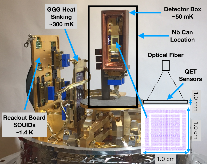Single electron–hole pair sensitive silicon detector with surface event discrimination
- Northwestern Univ., Evanston, IL (United States)
- Fermi National Accelerator Lab. (FNAL), Batavia, IL (United States); Univ. of Chicago, IL (United States)
- Univ. of Montreal, QC (Canada)
- Univ. of California, Berkeley, CA (United States)
- Texas A & M Univ., College Station, TX (United States)
Here, we demonstrate single electron-hole pair resolution in a single-sided, contact-free 1 cm$^2$ by 1 mm thick Si crystal operated at 48 mK, with a baseline energy resolution of 3 eV. This crystal can be operated at voltages in excess of $$\pm50$$ V, resulting in a measured charge resolution of 0.06 electron-hole pairs. The high aluminum coverage ($$\sim$$70%) of this device allows for the discrimination of surface events and separation of events occurring near the center of the detector from those near the edge. We use this discrimination ability to show that dark events seen in previous detectors of a similar design are likely dominated by charge leakage along the side wall of the device. We saw only a small reduction in dark event rate with this biasing scheme, further suggesting that sidewall and edge-dominated processes are responsible for the majority of these events.
- Research Organization:
- Fermi National Accelerator Laboratory (FNAL), Batavia, IL (United States)
- Sponsoring Organization:
- USDOE Office of Science (SC), High Energy Physics (HEP); National Science Foundation (NSF)
- Grant/Contract Number:
- AC02-07CH11359; PHY-1809730
- OSTI ID:
- 1542181
- Alternate ID(s):
- OSTI ID: 1776919
- Report Number(s):
- arXiv:1903.06517; FERMILAB-PUB-19-097-AE-E; oai:inspirehep.net:1725230
- Journal Information:
- Nuclear Instruments and Methods in Physics Research. Section A, Accelerators, Spectrometers, Detectors and Associated Equipment, Vol. 963; ISSN 0168-9002
- Publisher:
- ElsevierCopyright Statement
- Country of Publication:
- United States
- Language:
- English
Thermal detection of single e-h pairs in a biased silicon crystal detector
|
journal | January 2018 |
Gram-scale cryogenic calorimeters for rare-event searches
|
journal | July 2017 |
Results on MeV-scale dark matter from a gram-scale cryogenic calorimeter operated above ground: CRESST Collaboration
|
journal | September 2017 |
Calorimetric ionization detector
|
journal | April 1990 |
Single-Electron and Single-Photon Sensitivity with a Silicon Skipper CCD
|
journal | September 2017 |
Similar Records
A New Search for Low-mass Dark Matter and an Examination and Reduction of the Uncertainty due to the Photoelectric Absorption Cross Section using a Cryogenic Silicon Detector with Single-charge Sensitivity
Investigating the sources of low-energy events in a SuperCDMS-HVeV detector


